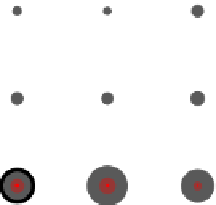Biology Reference
In-Depth Information
Temperature
53
°
C
48
°
C
37
°
C
0
1
2
3
Trypsin
Trypsin
LysC
100
Trypsin
RapiGest
1200
FIGURE 3.4
Evaluation of digestion efficiencies. For the bias-free determination of absolute protein
quantities, a complete digestion must be ensured. Detailed testing and optimization of digest
conditions, even with trypsin, are advisable. Here, the optimum temperature of 37
C and the
use of the surfactant RapiGest led to the best results for tryptic digests that are suitable
for SRM analyses in terms of the highest number of peptides without missed cleavages.
prior to generating quantitative data, as is shown in
Figure 3.4
. Peptides that result
from the incomplete digestion with one or more missed cleavage sites (
Brownridge
and Beynon, 2011
), and peptides with ragged ends (two or more arginine and/or
lysine residues in a row), should be avoided as candidate peptides for SRM
(
Barnidge
et al.
, 2004
).
The above criteria will lead to the production of a list of peptides that are both
proteotypic for the proteins under investigation and amenable, at least in theory,
for SRM analyses. The entire process for the selection of proteins with suitable pep-
tides, proteotypic peptides and transitions, as well as their validation and optimiza-
tion, will, in most cases, be aided by dedicated software suites (
Lange
et al.
, 2008
).
In targeted proteomics, absolute quantification is based on the comparison of
transition intensities for endogenous peptides versus their heavy-labelled spiked-
in counterparts. This may be achieved by spiking-in to the sample artificially syn-
thesized peptides (AQUA) or a QconCAT protein, prior to tryptic digestion to yield
appropriate heavy-labelled peptides. Depending on the method for the supply of the
isotopically labelled peptides, further restrictions may apply to the choice of peptides
needed for the targeted analyses, as discussed below.
4.2
Basic requirements for AQUA
Once a number of proteotypic peptides have been derived and the AQUA method
chosen for their production, the focus changes towards feasibility of their chemical
synthesis as heavy-labelled peptides. Currently, synthetic peptides of high purity are




















